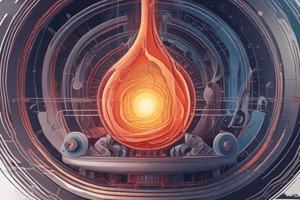Podcast
Questions and Answers
What is Cv related to in thermodynamics?
What is Cv related to in thermodynamics?
- Changes in external energy
- Changes in entropy
- Changes in pressure
- Changes in internal energy (correct)
What is C related to in thermodynamics?
What is C related to in thermodynamics?
- Changes in volume
- Changes in internal energy
- Changes in enthalpy (correct)
- Changes in entropy
What is the unit of measurement for specific heat capacity?
What is the unit of measurement for specific heat capacity?
- J/kg.K
- kJ/kg.K (correct)
- J/kg°C
- kJ/kg°C
Is the unit of measurement for specific heat capacity the same in Celsius and Kelvin?
Is the unit of measurement for specific heat capacity the same in Celsius and Kelvin?
What is the significance of specific heat capacity in thermodynamics?
What is the significance of specific heat capacity in thermodynamics?
What is the unit of the term 'ds' in the given equation?
What is the unit of the term 'ds' in the given equation?
What is the characteristic of a quasi-equilibrium process?
What is the characteristic of a quasi-equilibrium process?
What is the relation between 'P' and 'PdV' in the given equation?
What is the relation between 'P' and 'PdV' in the given equation?
What is the unit of 'W' in the equation?
What is the unit of 'W' in the equation?
What does the equation 'SWF ds = PA ds = PdV' represent?
What does the equation 'SWF ds = PA ds = PdV' represent?
What is a substance with a fixed chemical composition throughout?
What is a substance with a fixed chemical composition throughout?
Why is air considered a pure substance despite being a mixture of several gases?
Why is air considered a pure substance despite being a mixture of several gases?
What is a saturated vapor?
What is a saturated vapor?
What happens to the temperature of water during the phase-change process between states 1 and 5?
What happens to the temperature of water during the phase-change process between states 1 and 5?
What occurs when the entire process between states 1 and 5 is reversed by cooling the water while maintaining the pressure constant?
What occurs when the entire process between states 1 and 5 is reversed by cooling the water while maintaining the pressure constant?
What is true about the amount of heat released during the reversed process?
What is true about the amount of heat released during the reversed process?
What is the physical significance of the area under the process curve on a P-V diagram for a closed system?
What is the physical significance of the area under the process curve on a P-V diagram for a closed system?
What is the mathematical relationship between the area of the process curve and the work done on a closed system?
What is the mathematical relationship between the area of the process curve and the work done on a closed system?
What is the condition for a process to occur in a closed system, as depicted on a P-V diagram?
What is the condition for a process to occur in a closed system, as depicted on a P-V diagram?
Which of the following is a correct unit for the area under the process curve on a P-V diagram?
Which of the following is a correct unit for the area under the process curve on a P-V diagram?
What is the relationship between the path 'dA' and the pressure 'P' and volume change 'dV'?
What is the relationship between the path 'dA' and the pressure 'P' and volume change 'dV'?
What is the relationship between internal energy and temperature for an ideal gas?
What is the relationship between internal energy and temperature for an ideal gas?
What is the expression for enthalpy h in terms of internal energy u and gas constant R?
What is the expression for enthalpy h in terms of internal energy u and gas constant R?
What is the relationship between the change in internal energy and the specific heat capacity at constant volume?
What is the relationship between the change in internal energy and the specific heat capacity at constant volume?
What is the relationship between the change in enthalpy and the specific heat capacity?
What is the relationship between the change in enthalpy and the specific heat capacity?
What was the purpose of the experimental apparatus used by Joule, as shown in the schematic?
What was the purpose of the experimental apparatus used by Joule, as shown in the schematic?




